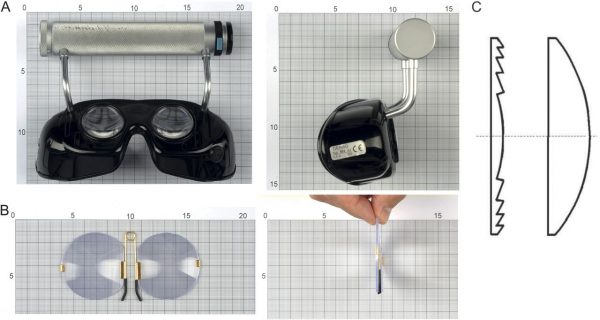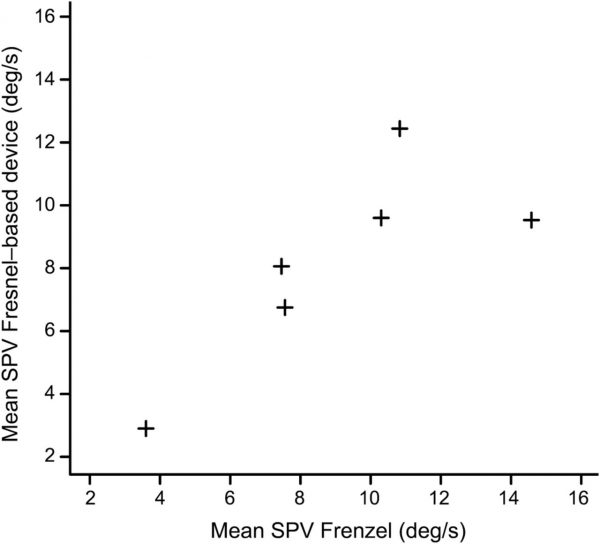

A Fresnel-based device
Michael Strupp, Carolin Fischer, Lena Hanß, Otmar Bayer
Abstract
Objective: To develop and evaluate new thin and light glasses for the examination of patients with nystagmus and to compare them with Frenzel goggles.
Methods: First, we designed new examination glasses: a Fresnel-based device with a short focal length that is not as heavy or bulky as Frenzel goggles. Second, visual-fixation suppression of postrotatory nystagmus with Frenzel goggles and the Fresnel-based device, the latter with 2 different magnifications (2- and 4-fold), was compared in 13 healthy subjects. Third, the intensity of the peripheral vestibular spontaneous nystagmus–in 6 patients with acute vestibular neuritis–with the Frenzel goggles and the Fresnel-based device with the 4-fold magnification was compared. Fourth, the visibility and clinical applicability were evaluated.
Results: The Fresnel-based device weighs 6 g (dimensions 12 × 8 × 0.3 cm). There was no significant difference in the intensity of postrotatory nystagmus between the Fresnel-based device with 4-fold magnification (37.3 ± 17.9°/s) and the Frenzel goggles (39.0 ± 18.3°/s). There was also no significant difference between the intensity of peripheral vestibular spontaneous nystagmus in the patients with acute vestibular neuritis. The Fresnel-based device can be easily applied.
Conclusion: For suppression of nystagmus, the new Fresnel-based device or so-called M glasses is not inferior to Frenzel goggles. Doctors can carry it in their pocket, it is inexpensive, and easy to handle and to fix to the patient’s nose so that it can be used in daily practice for the bedside examination.
Full text: https://n.neurology.org/content/neurology/83/14/1241.full.pdf

Figure 1 Frenzel goggles, takeaway Frenzel goggles, and construction of the Fresnel lenses
(A) Frenzel goggles, a commercially available tool for the examination of nystagmus: magnification by glass spectacle lenses about 16 diopters, dimensions approximately 20 × 13 × 7 cm, and weight approximately 500 g. (B) The takeaway Frenzel goggles, a Fresnel-based device, is a newly designed tool for the bedside examination of nystagmus: magnification by Fresnel plastic lenses about 16 diopters, dimensions 12 × 8 × 0.3 cm, and weight 6 g. (C) Schematic drawing showing comparison of Fresnel lenses (left) and regular lenses (right) to illustrate the basic principle of Fresnel lenses, which leads to the smaller dimensions.

Figure 2 Plot of mean slow-phase velocity of the different goggles
Plotting the mean peak slow-phase velocity (mSPV) measured with the Fresnel-based device with the 4-fold magnification (y) and Frenzel goggles in 6 patients with spontaneous peripheral nystagmus suggests a linear relation. This indicates that the fixation suppression achieved by the Fresnel-based device is constantly 0.69 times that of the Frenzel goggles, irrespective of the intensity (mSPV) of the spontaneous nystagmus.
First published August 27, 2014, DOI: https://doi.org/10.1212/WNL.0000000000000838
GLOSSARY
CI=confidence interval;
D=diopter;
mSPV=mean slow-phase velocity
